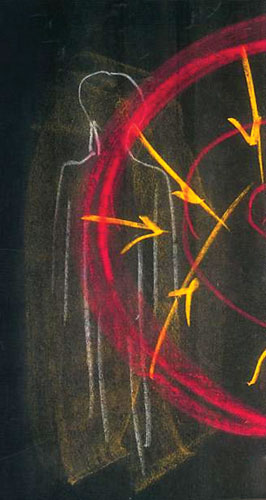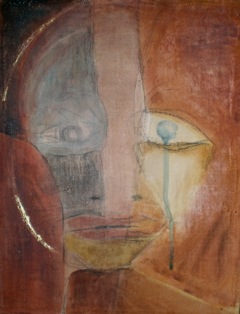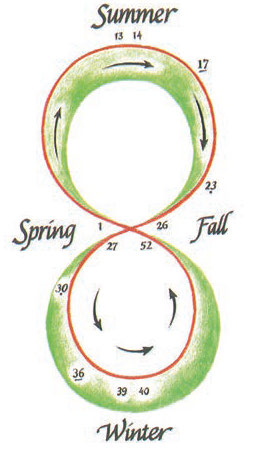Human Nature and Evolution

Rudolf Steiner was born two years after the publication of Charles Darwin’s The Origin of Species. Science could now see the human being as a higher animal evolved merely through the stress of survival.
Religion’s ancient claim to know a divine origin of the human being began to lose conviction. Nietzsche would soon assert that “God is dead and we have killed him.” Morality—any morality—began to be questioned as a mere means of control. And by the time of Steiner’s death in 1925, the senseless violence of the First World War had destroyed European confidence in human goodness or perfectibility.
Steiner worked on the question of the human makeup and nature throughout his life. As a foundation he researched the being of thinking and the unification of sense perceptions with concepts to form “reality.” He worked with Goethe’s method of receptive observation, letting carefully observed phenomena speak for themselves.
After the turn of the 20th century, he put forward a series of “basic books” which detailed the raising of consciousness (How to Know Higher Worlds), the nature of the soul and its world (Theosophy), and human cosmic origins (An Outline of Esoteric Science, fifty years after Darwin’s revelations).
The human being is mineral, in the corpse we leave behind. We are living, like plants, sentient like animals, and—uniquely—the bearer of an ego, the self, the “I Am.” We have evolutionary potential beyond that, out of our own nature. We are evolving humanly on the plane of consciousness, not physical survival. In the 1960s, from the practical perspective of a “hierarchy of needs” that are required for “self-actualization,” or healthy humanness, the American psychologist Abraham Maslow reached similar insights, including an ultimate potential for going further: for “self-transcendence.” Steiner’s term for that is “spirit self.”
Steiner’s holistic understanding of human nature and being has immense usefulness for both individual and community life. As we approach a dramatic encounter with artificial intelligence (AI) and robotics as a collaborator or competitor or replacement, Steiner’s view of our nature and potential is enormously timely.
The Shape of Our Lives

Many of Steiner’s insights correspond to ancient wisdom. He was adamant, however, in asserting that he proceeded first with his own research and only then compared this to sacred texts and traditions. This is confirmed by the fact that his reports constantly enrich and expand on what has been handed down. Another of his “basic books,” Christianity as Mystical Fact, reconnects the religion of Christianity with the preceding “mystery religions” with startling implications.
Our daily lives are the easiest place to find greater meaning arising out of Steiner’s research. For their largest context, he reaffirms the ancient idea of repeated lives. As people have said in recent years, “we are spiritual beings having a human experience”—not the reverse. In Shakespeare's words, “All the world's a stage, and all the men and women merely players.”
For Steiner, however, this is not “merely” playing: it is a process of development of our enduring beings. His Calendar of the Soul pictures us weekly through the seasons, being dipped repeatedly into the same sequence of earthly-solar-cosmic moods and situations, growing into awareness of our deep engagement with the whole world. If we are acting now as players, we are working toward becoming authors.
Shakespeare follows the words above with a great parody of the “seven ages of man,” but Steiner accounts serious meaning to seven year periods and their labors, first in our body and life and sensitivities, later in the evolving relation of our self to the world. In the greater picture we begin to perceive now a rising spiral, the Eastern circle of recurrence united with the Western line of progress. “There is no great and no small to the Soul that maketh all,” said Emerson; any aspect of a human existence can be opened up to reveal the interest and significance which the age of materialism had flattened out.
“My soul and the world are but one...”

The modern cultural paradigm has separated us humans from the world in which we are still, in fact, embedded. This was not simply a mistake; by moving the human being out of the conceptual center of reality, we could become detached and “objective” observers.
But this detachment, it now appears, is increasingly from ourselves.
By restoring humanity and human consciousness to its truly central place, Rudolf Steiner’s worldview, “anthroposophy,” reopens a host of important questions.
And it suggests that the undesirable and perhaps catastrophic aspects of modern civilization may be overcome by raising ourselves to a standpoint that includes science but rises higher.
Check back soon, there is much more to come in this space! And let us know what you think...
A “calendar of the soul”
In 1912 Steiner provided a “calendar of the soul,” weekly verses that express how the changing seasons in the natural world and in our own inner lives are helping our consciousness evolve.
[View and download here a guide by Herbert O. Hagens to dates for the Calendar in 2020-2021.]
In an article first published in Orion magazine in Autum 1999, “The One Life Within Us and Abroad,” Prof. Gertrude Reif Hughes describes Steiner’s Calendar as a personal awakening. “That year I became able to “read” the Soul Calendar as Steiner designed it to be read—meditatively.
The Calendar began to offer its gifts to me, and for the next seven years I worked with it almost daily. I saw that the verses are more like koans than poems. The descriptions not only represented processes around me but awakened me to processes occurring within my soul. Earlier I hadn’t felt that echoing, which is fundamental to the Calendar. Now I began to confirm it in my own experience.
You can read Prof. Hughes’ full article, reprinted in the Fall 2012 issue of being human, as part of a special section on the centenary the Calendar,linked here.
There are many online editions of the Calendar of the Soul. The one at the Lili Kolisko Institute allows you to click through to Steiner’s eurythmy form for that week’s verse. Another version offers many translations with original text, and other special features. (If initially you see only the German, hover your mouse pointer over the text to see options.)

